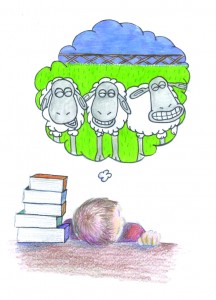
Greenwich High School has a club that meets every Monday. They have a teacher advisor, club presidents, and a growing student following.
Their weekly meeting goal: taking a 20-minute nap.
Greenwich High School is one of the first schools to officially recognize the needs for naptime with the creation of the Power Nap Club in 1998.
According to a 2002 CBS article featuring the club, its motto is “veni vidi dormivi,” a Latin phrase that translates to “I came, I saw, I slept.”
Naps have made their way into the lives of Staples students, and many depend on their daily power naps to become reenergized for the rest of the evening.
Tori Stewart ’12 fits about a 20-minute nap into her schedule every day.
“I will take a nap as soon as I get home from school, and if necessary, I’ll take a second one around five,” Stewart said.
Stewart admits that her naps are due to exhaustion caused by the demanding seven-hour school day.
Although napping may take away homework time, the National Sleep Foundation says a 20-30 minute nap provides one with improved alertness and performance.
A study was conducted at NASA on sleepy military pilots and astronauts; the researchers found that after a 40-minute nap, performance improved by 34 percent and alertness improved by 100 percent.
Like Stewart, many other students have fit power naps into their daily routines.
Danielle Williams ’13 takes a nap for about 45 minutes two times a week. Izzy Baker ’12 also finds herself taking a nap two-three times per week around 5 p.m. after she completes her extracurricular and some homework.
“After about a 30-minute nap, I’ll feel more refreshed and I’ll have boost of energy,” Baker said.
Williams usually feels renergized after naps, but frequently she wants to continue sleeping.
“Sometimes a nap does not help my performance afterwards because all I feel like doing is going back to sleep,” Williams said.
Baker agreed with Williams, and sometimes feels the same groggy effect after taking a power nap.
But usually, Stewart feels a lot more ready to do her work after her naps.
The NSF notes that this groggy feeling both students experience is caused by sleep inertia which occurs after waking from a deep sleep.
This feeling is generated after sleeping for longer than 20 minutes.
Sleep inertia can be “detrimental to those who must perform immediately after waking from a napping period.”
Then there are other students, like Jordan Glick ’11, who only nap in rare cases.
“I take power naps when I find myself with a little bit of extra time and when I’m very exhausted and still have some work to do,” Glick said.
In the CBS News article about the Power Nap Club, members stated that there is such a necessity for naps in high school because of all the pressure that is put on students to succeed.
In Westport, students are being pulled in different directions, and it seems only is only appropriate for students to be exhausted by 5 p.m., at least.
But there are students, such as Ellen Kaminski ’11, who cannot escape the pressure via napping.
“I have not napped since I was a baby,” Kaminski said.
Kaminski physically cannot nap because she is sensitive to the light. This definitely affects her levels of tiredness, especially because she does not get enough sleep at night either.
“Next year in college I definitely think it will be hard to adapt to a new sleep schedule where everyone takes naps during the day,” Kaminski said.
Although naps could be beneficial for students, the NSF says the most effective way to feel alert during the day is to get enough sleep on a regular basis.













































